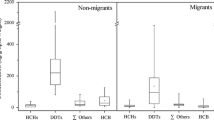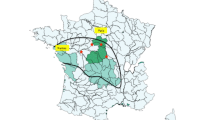Abstract
We determined the concentrations and residue patterns of 20 persistent organochlorine pesticides (OCPs), including hexachlorocyclohexanes (HCHs), hexachlorobenzene, dichlorodiphenyltrichloroethanes (DDTs), chlordane-related compounds (CHLs), mirex, dieldrin, endrin, and aldrin, in muscle of rainbow trout from Lake Mashu, Japan. Total concentrations of OCPs varied from 1.0 to 132 ng g−1 lipid weight. α-HCH was the most prevalent OCP contaminant in the fish muscle. Using the daily fish consumption in Japan (95.2 g), the mean weight of a Japanese adult (50.0 kg), and residual pesticide concentrations, we calculated the estimated daily intakes of γ-HCH, DDTs, CHLs, and dieldrin for humans to be 0.39, 0.48, 0.68, and 0.08 ng kg−1 day−1, respectively. Judging from acceptable daily intakes established by the Food and Agriculture Organization of the United Nations and the World Health Organization, we believe that these OCP levels would not adversely affect human health.




Similar content being viewed by others
References
AMAP (Arctic Monitoring and Assessment Program) (1998). AMAP assessment report. In Arctic pollution issues. Retrieved from http://www.amap.no.
Aulagnier, F., & Poissant, L. (2005). Some pesticides occurrence in air and precipitation in Quebec, Canada. Environmental Science & Technology, 39, 2960–2967.
Bailey, R. E. (2001). Global hexachlorobenzene emissions. Chemosphere, 43, 167–182.
Barrie, L. A., Gregor, D., Hargrave, B., Lake, R., Muir, D., Shearer, R., et al. (1992). Arctic contaminants: sources, occurrence and pathways. Science of the Total Environment, 122, 1–74.
Bustnes, J. O., Hanssen, S. A., Folstad, I., Erikstad, K. E., Hasselquist, D., & Skaare, J. U. (2004). Immune function and organochlorine pollutants in Arctic breeding glaucous gulls. Archives of Environmental Contamination and Toxicology, 47, 530–541.
Calamari, D., Bacci, E., Focardi, S., Gaggi, C., Morosini, M., & Vighi, M. (1991). Role of plant biomass in the global environmental partitioning of chlorinated hydrocarbons. Environmental Science & Technology, 25, 1489–1495.
Carlson, D. L., Basu, I., & Hites, R. A. (2004). Annual variations of pesticide concentrations in Great Lakes precipitation. Environmental Science & Technology, 38, 5290–5296.
Carrera, G., Fernández, P., Grimalt, J. O., Ventura, M., Camarero, L., Catalan, J., et al. (2002). Atmospheric deposition of organochlorine compounds to remote high mountain lakes of Europe. Environmental Science & Technology, 36, 2581–2588.
Cleemann, M., Riget, F., Paulsen, G. B., de Boer, J., Klungsøyr, J., & Aastrup, P. (2000). Organochlorines in Greenland lake sediments and landlocked Arctic char (Salvelinus alpinus). Science of the Total Environment, 245, 173–185.
Doong, R. A., Peng, C. K., Sun, Y. C., & Liao, P. L. (2002). Composition and distribution of organochlorine pesticide residues in surface sediments from the Wu-Shi River Estuary, Taiwan. Marine Pollution Bulletin, 45, 246–253.
Falandysz, J., Strandberg, L., Puzyn, T., Gucia, M., & Rappe, C. (2001). Chlorinated cyclodiene pesticide residues in blue mussel, crab, and fish in the Gulf of Gdañsk, Baltic Sea. Environmental Science and Technology, 35, 4163–4169.
FAO/WHO (Food and Agriculture Organization of the United Nations and World Health Organization) (2002). Joint FAO/WHO Meeting on Pesticide Residues. Inventory of IPCS and other WHO pesticide evaluations and summary of toxicological evaluations performed by the Joint Meeting on Pesticide Residues (JMPR) Evaluations through 2002. Retrieved from http://www.inchem.org/documents/jmpr/jmpeval/jmpr2002.htm.
Fellers, G. M., McConnell, L. L., Pratt, D., & Datta, S. (2004). Pesticides in mountain yellow-legged frogs (Rana muscosa) from the Sierra Nevada Mountains of California, USA. Environmental Toxicology and Chemistry, 23, 2170–2177.
Fromberg, A., Cleemann, M., & Carlsen, L. (1999). Review on persistent organic pollutants in the environment of Greenland and Faroe Islands. Chemosphere, 38, 3075–3093.
Iwata, H., Tanabe, S., Sakai, N., & Tatsukawa, R. (1993). Distribution of persistent organochlorines in the oceanic air and surface seawater and the role of ocean on their global transport and fate. Environmental Science & Technology, 27, 1080–1098.
Jones, K. C., & de Voogt, P. (1999). Persistent organic pollutants (POPs): State of the science. Environmental Pollution, 100, 209–221.
Kallenborn, R. (2006). Persistent organic pollutants (POPs) as environmental risk factors in remote high-altitude ecosystems. Ecotoxicology and Environmental Safety, 63, 100–107.
Kannan, K., Tanabe, S., & Tatsukawa, R. (1995). Geographical distribution and accumulation features of organochlorine residues in fish in tropical Asia and Oceania. Environmental Science & Technology, 29, 2673–2683.
Li, J., Zhu, T., Wang, F., Qiu, X. H., & Lin, W. L. (2006). Observation of organochlorine pesticides in the air of the Mt. Everest region. Ecotoxicology and Environmental Safety, 63, 33–41.
Licata, P., Bella, G. D., Dugo, G., & Naccari, F. (2003). Organochlorine pesticides, PCBs and heavy metals in tissues of the mullet Liza aurata in lake Ganzirri and Straits of Messina (Sicily, Italy). Chemosphere, 52, 231–238.
Loganathan, B. G., Tanabe, S., Goto, M., & Tatsukawa, R. (1989). Temporal trends of organochlorine residues in lizard goby Rhinogobius flumineus from the river Nagaragawa, Japan. Environmental Pollution, 62, 237–251.
Meijer, S. N., Halsall, C. J., Harner, T., Peters, A. J., Ockenden, W. A., Johnston, A. E., et al. (2001). Organochlorine pesticide residues in archived UK soil. Environmental Science and Technology, 35, 1989–1995.
Mikaelian, I., de Lafontaine, Y., Harshbarger, J. C., Lee, L. L., & Martineau, D. (2002). Health of lake whitefish (Coregonus clupeaformis) with elevated tissue levels of environmental contaminants. Environmental Toxicology and Chemistry, 21, 532–541.
Ministry of Health and Welfare (1995). National nutrition survey search. Tokyo: Government of Japan.
Ministry of the Environment (2005). Chemicals in the environment. Tokyo: Government of Japan.
Monirith, I., Nakata, H., Tanabe, S., & Tana, T. S. (1999). Persistent organochlorine residues in marine and freshwater fish in Cambodia. Marine Pollution Bulletin, 38, 604–612.
Monirith, I., Ueno, D., Takahashi, S., Nakata, H., Sudaryanto, A., Subramanian, A., et al. (2003). Asia-Pacific mussel watch: monitoring contamination of persistent organochlorine compounds in coastal waters of Asian countries. Marine Pollution Bulletin, 46, 281–300.
Paasivirta, J., Rantio, T., Koistinen, J., & Vuorinen, P. J. (1993). Studies on toxaphene in the environment. II. PCCs in Baltic and Arctic Sea and lake fish. Chemosphere, 27, 2011–2015.
Pandit, G. G., Sahu, S. K., & Sadasivan, S. (2002). Distribution of HCH and DDT in the coastal marine environment of Mumbai, India. Journal of Environmental Monitoring, 4, 431–434.
Perugini, M., Giammarino, A., Olivieri, V., Di Nardo, W., & Amorena, M. (2006). Assessment of edible marine species in the Adriatic Sea for contamination from polychlorinated biphenyls and organochlorine insecticides. Journal of Food Protection, 69, 1144–1149.
Phillips, D. J. H., & Tanabe, S. (1989). Aquatic pollution in the Far East. Marine Pollution Bulletin, 20, 297–303.
Roots, O. (2001). Halogenated environmental contaminants in fish from Estonian coastal areas. Chemosphere, 43, 623–632.
Ross, R. D., & Crosby, D. G. (1985). Photooxidant activity in natural waters. Environmental Toxicology and Chemistry, 4, 773–778.
Ruus, A., Ugland, K. I., Espeland, O., & Skaare, J. U. (1999). Organochlorine contaminants in a local marine food chain from Jarfjord, northern Norway. Marine Environmental Research, 48, 131–146.
Simonich, S. L., & Hites, R. A. (1995). Global distribution of persistent organochlorine compounds. Science, 269, 1851–1854.
Sudo, M., Kunimatsu, T., & Okubo, T. (2002). Concentration and loading of pesticide residues in Lake Biwa basin (Japan). Water Research, 36, 315–329.
Suntio, L. R., Shiu, W. Y., Mackay, D., Seiber, J. N., & Glotfelty, D. (1988). Critical review of Henry’s Law constants for pesticides. Reviews of Environmental Contamination and Toxicology, 103, 1–59.
Takazawa, Y., Tanaka, A., Shibata, Y., & Morita, M. (2005). Levels of organochlorine compounds in bivalves from the Japanese coastal waters: results from the environmental specimen bank in Japan. Bulletin of Environmental Contamination and Toxicology, 75, 561–568.
Tsutsumi, T., Yanagi, T., Nakamura, M., Kono, Y., Uchibe, H., Iida, T., et al. (2001). Update of daily intake of PCDDs, PCDFs, and dioxin-like PCBs from food in Japan. Chemosphere, 45, 1129–1137.
Vilanova, R., Fernández, P., Martínez, C., & Grimalt, J. O. (2001). Organochlorine pollutants in remote mountain lake waters. Journal of Environmental Quality, 30, 1286–1295.
Vine, M. F., Stein, L., Weigle, K., Schroeder, J., Degnan, D., Tse, C. K., et al. (2000). Effects on the immune system associated with living near a pesticide dump site. Environmental Health Perspectives, 108, 1113–1124.
Weber, K., & Goerke, H. (2003). Persistent organic pollutants (POPs) in Antarctic fish: levels, patterns, changes. Chemosphere, 53, 667–678.
WHO (World Health Organization) (1992). Alpha- and beta-hexachlorocyclohexanes. Environmental health criteria 123. Geneva: WHO
Willett, K. L., Ulrich, E. M., & Hites, R. A. (1998). Differential toxicity and environmental fates of hexachlorocyclohexane isomers. Environmental Science & Technology, 32, 2197–2207.
Wong, M. H., Leung A. O., Chan, J. K., & Choi, M. P. (2005). A review on the usage of POP pesticides in China, with emphasis on DDT loadings in human milk. Chemosphere, 60, 740–752.
Yamaguchi, N., Gazzard, D., Scholey, G., & Macdonald, D. W. (2003). Concentrations and hazard assessment of PCBs, organochlorine pesticides and mercury in fish species from the upper Thames: River pollution and its potential effects on top predators. Chemosphere, 50, 265–273.
Yang, N., Matsuda, M., Kawano, M., & Wakimoto, T. (2006). PCBs and organochlorine pesticides (OCPs) in edible fish and shellfish from China. Chemosphere, 63, 1342–1352.
Yim, U. H., Hong, S. H., Shim, W. J., & Oh, J. R. (2005). Levels of persistent organochlorine contaminants in fish from Korea and their potential health risk. Archives of Environmental Contamination and Toxicology, 48, 358–366.
Acknowledgments
This work was supported by the Center for Global Environmental Research (CGER) in National Institute for Environmental Studies. Fish samples collected in the Global Environment Monitoring System/Water Program were provided by the courtesy of CGER.
Author information
Authors and Affiliations
Corresponding author
Rights and permissions
About this article
Cite this article
Takazawa, Y., Tanaka, A. & Shibata, Y. Organochlorine Pesticides in Muscle of Rainbow Trout from a Remote Japanese Lake and Their Potential Risk on Human Health. Water Air Soil Pollut 187, 31–40 (2008). https://doi.org/10.1007/s11270-007-9494-x
Received:
Accepted:
Published:
Issue Date:
DOI: https://doi.org/10.1007/s11270-007-9494-x




